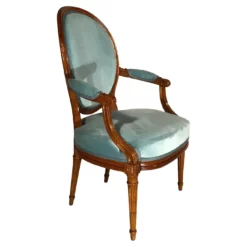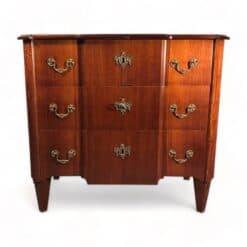Best Sellers
Antique and Vintage Seating
Antique Furniture and Decor
Antique Furniture and Decor
Antique Furniture and Decor
Antique Furniture and Decor
Antique Furniture and Decor
Antique Furniture and Decor
Antique Furniture and Decor
Antique and Vintage Seating
Neoclassical Daybed Style of Henri Jacob, France around 1820
Antique Furniture and Decor
Antique Furniture and Decor
Antique Furniture and Decor
Furniture, Style, Styylish History
German Louis XVI Furniture, The Zopfstil – History and Design
The Louis XVI period, spanning the late 18th century, marked a shift toward classical ideals in furniture design across Europe. In Germany, this style evolved into a distinct interpretation known as Zopfstil. Translating to “braid style,” Zopfstil uniquely combined the restrained elegance of Neoclassicism with German influences. In this blog, we will delve into the history and defining characteristics of this remarkable design style, showcasing why it remains significant today.
Historical Context of Zopfstil
To begin, it’s important to understand the broader context of the 18th century. During this period, Europe experienced profound cultural changes. As Rococo’s ornate, playful designs fell out of favor, a new admiration for classical antiquity emerged. This shift was heavily influenced by archaeological discoveries in Pompeii and Herculaneum, sparking a revival of Greco-Roman aesthetics across the continent.

In France, under the reign of Louis XVI, this movement gave birth to Neoclassicism, which emphasized symmetry, proportion, and restraint. Germany, although fragmented into numerous states, eagerly adopted and adapted these trends. The result was Zopfstil, a German interpretation of the French style.
Interestingly, the term Zopfstil initially had a derisive connotation, mocking the style’s perceived stiffness. However, as time passed, it became a neutral descriptor of the balanced and refined designs that typify this era.

Key Features of German Louis XVI Furniture
German Louis XVI furniture, or Zopfstil, is renowned for its disciplined elegance. While it shares similarities with French Neoclassicism, it also exhibits distinct features that reflect German tastes and craftsmanship.
1. Materials and Craftsmanship
First and foremost, Zopfstil furniture highlights exceptional craftsmanship. Artisans favored solid woods such as walnut, cherry, and mahogany, ensuring durability and beauty. Additionally, they often employed veneering techniques to showcase striking contrasts between light and dark grains.
Moreover, marquetry—intricate inlays of wood or other materials—was a common decorative element. These designs ranged from geometric patterns to floral motifs, adding a subtle yet striking visual appeal.
2. Architectural Lines
Another hallmark of Zopfstil furniture is its architectural quality. Inspired by classical proportions, these pieces feature straight lines and balanced forms. Unlike the curves of Rococo, Zopfstil emphasized structure and order. However, to soften the rigidity, elements such as rounded corners and tapered legs were introduced.

3. Ornamentation and Motifs
At the same time, German Louis XVI furniture retained some decorative elements. However, unlike the flamboyance of Rococo, these were understated. Common motifs included laurel wreaths, fluting, festoons, and medallions—symbols borrowed from antiquity. These embellishments were thoughtfully applied, creating a sense of restrained luxury.
4. Practical Elegance
Zopfstil furniture not only looked refined but also served functional purposes. Pieces such as writing desks and secretaries were designed with clever compartments and efficient layouts, embodying Enlightenment ideals of practicality and organization.
5. Painted and Gilded Finishes
Lastly, while natural wood finishes were predominant, painted and gilded pieces also appeared. Urban centers like Berlin and Dresden favored light pastel tones accented with gold leaf, reflecting the influence of French design trends.

Signature Furniture Types in Zopfstil
Zopfstil produced several iconic furniture types, each embodying the style’s unique blend of form and function.
1. Commodes
First, the commode became a centerpiece of Zopfstil design. These rectangular storage pieces often featured marble tops and were adorned with subtle inlays or carvings. Their elegant simplicity made them both functional and decorative.
2. Writing Desks and Secretaries
Next, writing furniture played a prominent role in this era. Writing desks typically had clean lines and tapered legs, while secretaries boasted ingenious compartments and drop-front surfaces. These designs reflect the period’s focus on intellectual pursuits and organization.
3. Chairs and Sofas
Seating in the Zopfstil style combined comfort with classicism. Chairs featured straight or slightly concave backs, often upholstered in elegant fabrics. Similarly, sofas embraced symmetry and understated charm, making them perfect for both formal and informal settings.

4. Cabinets and Buffets
Finally, cabinets and buffets showcased Zopfstil’s adaptability. These pieces often served as showcases for fine china or books, with symmetrical forms and restrained decorations that harmonized with their surroundings.
Cultural Influences on Zopfstil
Furthermore, Zopfstil was influenced by broader cultural trends. Germany, during this time, was deeply shaped by Enlightenment ideals. These principles—order, rationality, and simplicity—found expression in the furniture of the period.

Royal courts, such as Frederick the Great’s in Berlin, played a significant role in popularizing Zopfstil. However, the style also gained traction among the growing bourgeoisie, who appreciated its combination of elegance and practicality. This widespread appeal ensured Zopfstil’s enduring legacy.
Zopfstil’s Enduring Appeal
Although Zopfstil’s popularity waned with the rise of the Empire style in the early 19th century, its influence persists. Today, antique collectors and design enthusiasts prize these pieces for their timeless elegance and exceptional craftsmanship.
Importantly, German Louis XVI furniture remains relevant in contemporary design. Its clean lines and neutral palette make it easy to incorporate into modern interiors, offering a bridge between past and present.
Integrating Zopfstil into Modern Spaces
If you’re considering adding Zopfstil furniture to your home, you’ll be pleased to know it pairs beautifully with contemporary decor. Here are a few tips:
- Pair with Minimalist Décor
To begin, let Zopfstil pieces shine by surrounding them with simple, understated elements. A Zopfstil commode, for example, can serve as a striking focal point in a minimalist room. - Mix Textures
Additionally, combine natural wood finishes with modern materials like glass or steel. This contrast highlights the craftsmanship of Zopfstil while creating a dynamic visual balance. - Use Lighting Thoughtfully
Finally, proper lighting can elevate Zopfstil furniture. Warm, ambient lighting accentuates intricate carvings and marquetry, enhancing their visual appeal.

Conclusion
In conclusion, German Louis XVI furniture, or Zopfstil, stands as a remarkable chapter in design history. Emerging during a time of cultural and artistic transformation, it reflects the enduring allure of Neoclassicism with a distinctly German sensibility.
Whether you’re an antique collector or a design enthusiast, exploring Zopfstil opens a window into the elegance and craftsmanship of 18th-century Germany. These pieces not only celebrate history but also offer timeless beauty for modern living spaces.
Silke Berlinghof
People also buy
Antique Furniture and Decor
Antique Furniture and Decor
Nesting Tables
Antique and Modern Pedestals and Columns
Pair of Large Neoclassical Columns, Pine Wood, France circa 1910
Antique Furniture and Decor
Rhenish Altarpiece, Dormition, Wood Bas-relief, 19th century
Antique Furniture and Decor
Console Tables
Desks and Secretary Desks
Antique Furniture and Decor
Antique Furniture and Decor
Antique Furniture and Decor
















































